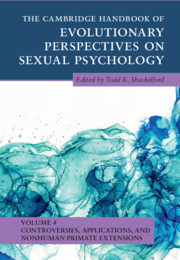Book contents
- The Cambridge Handbook of Evolutionary Perspectives on Sexual Psychology
- The Cambridge Handbook of Evolutionary Perspectives on Sexual Psychology
- Copyright page
- Contents
- Contributors
- Preface
- Part I Controversies and Unresolved Issues
- Part II Applications to Health, Law, and Pornography
- 6 Male Reproductive Health
- 7 Women’s Menstrual Cycles and Ovulation Provide Balanced Estradiol and Progesterone for Fertility and Lifelong Health
- 8 Female Genital Cutting
- 9 Costs of Polygyny
- 10 Male Sexual Disorders
- 11 An Evolutionary Perspective on Female Sexual Concerns and Dysfunctions
- 12 Evolutionary Perspectives on Male Sexual Offending
- 13 Pornography and Male Sexual Psychology
- Part III Nonhuman Primate Sexual Behavior
- Index
- References
7 - Women’s Menstrual Cycles and Ovulation Provide Balanced Estradiol and Progesterone for Fertility and Lifelong Health
from Part II - Applications to Health, Law, and Pornography
Published online by Cambridge University Press: 30 June 2022
- The Cambridge Handbook of Evolutionary Perspectives on Sexual Psychology
- The Cambridge Handbook of Evolutionary Perspectives on Sexual Psychology
- Copyright page
- Contents
- Contributors
- Preface
- Part I Controversies and Unresolved Issues
- Part II Applications to Health, Law, and Pornography
- 6 Male Reproductive Health
- 7 Women’s Menstrual Cycles and Ovulation Provide Balanced Estradiol and Progesterone for Fertility and Lifelong Health
- 8 Female Genital Cutting
- 9 Costs of Polygyny
- 10 Male Sexual Disorders
- 11 An Evolutionary Perspective on Female Sexual Concerns and Dysfunctions
- 12 Evolutionary Perspectives on Male Sexual Offending
- 13 Pornography and Male Sexual Psychology
- Part III Nonhuman Primate Sexual Behavior
- Index
- References
Summary
Periodic vaginal bleeding occurs in humans (who are henceforth called “women,” a word describing culture as well as biology), old-world apes, and few other mammals. By current concepts, women’s menstrual cycles provide estrogen for thirty to fifty years; following one year of no flow they become menopausal and “estrogen deficient.” By contrast we now know that the purpose of menstrual cycles is to supply all cells and tissues with the balanced essential actions of estradiol (E2) and progesterone (P4) produced in feedback-controlled patterns to facilitate fecundability and preserve younger women’s well-being. We also now know that menopausal women’s health is negatively affected (by increased osteoporosis, heart disease, breast and endometrial cancers) if those past menstrual cycles produced inadequate net P4 to counterbalance and complement E2’s actions. Menstrual periodicity, flow, and ovulatory characteristics in women reflect the integrated actions/interactions of the central nervous system through the hypothalamus and pituitary, ideally leading to each cycle’s stimulation of a dominant egg-containing follicle. That follicle, by central complex feedback loops, produces the cyclic, graded amounts of estradiol (E2) and progesterone (P4) for that three- to five-week period and releases a viable egg. Central reproductive connections allow adult premenopausal women’s menstrual cycle periodicity, ovulation or not, and luteal phase lengths, that can be adapted to the challenges and demands of each woman’s current physiological and sociocultural/emotional environments. These new ideas are based on the differing and complementary cellular and tissue actions of E2 and P4. E2 is essential for cell growth and stimulates cell proliferation. P4 uniquely counterbalances and controls proliferation while stimulating cell differentiation and tissue maturation. Thus, E2–P4 actual and relative productions integrate cycles within each woman’s reproductive lifecycle (adolescent, premenopausal, perimenopausal), and are related to her nutrition, illness, energy expenditure, and social/emotional/spiritual environments. The subtlest indication of a stressed reproductive system is truncated P4 production in the short luteal phase within a normal-length, ovulatory menstrual cycle. This adaptation protects a woman from pregnancy when she has inadequate net energy balance or is under emotional/social/spiritual or physical duress. Thus, a normal luteal phase length within a three- to five-week regular menstrual cycle is a bellwether of women’s well-being. By contrast, regular cycles with ovulatory disturbances (anovulation or short luteal phases; E2>P4) predict current decreased well-being and poor later life health. The purpose of this review is to provide a practical approach to understanding this new women’s menstrual cycle balanced E2–P4 paradigm applied to common clinical situations including subfertility with regular cycles, premenstrual symptoms, and heavy menstrual flow.
Keywords
- Type
- Chapter
- Information
- Publisher: Cambridge University PressPrint publication year: 2022

